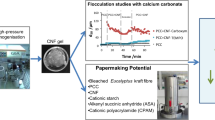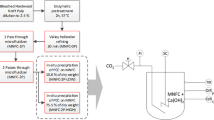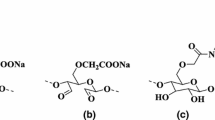Abstract
In this work, cellulose nanofibrils (CNF) were produced from a Eucalyptus globulus bleached kraft pulp by TEMPO-mediated oxidation and mechanical homogenisation, and their effects in papermaking, namely filler flocculation and retention, dry and wet-web strength and structural properties, were studied in detail. Cellulose nanofibrils possessing 0.6 mmol/g carboxyl groups and a degree of polymerisation (DP) of ca. 550 were found to promote filler flocculation and retention in the fibre mat, whereas the same amount (3 wt%) of CNF having 1.5 mmol/g of carboxyl groups, a DP of ca. 200 and a similar mean diameter exhibited the opposite effect. These results were interpreted with the help of flocculation studies of precipitated calcium carbonate (PCC) in the presence of CNF carried out by laser diffraction spectrometry. In addition, the mechanical and structural properties of the handsheets were analysed, revealing that the less charged CNF led to more closed matrices and, even increasing the filler retention, had a positive role on the tensile strength. A bonding mechanism among eucalypt fibres, PCC, CNF and a linear cationic polyacrylamide is proposed, consistent with the flocculation, retention and paper strength and structural property results. It is concluded that, to be used in papermaking, the CNF must not have a high charge (or a small length) to be able to flocculate the filler particles and, at the same time, to increase the filler-to-cellulosic fibres bonding. A complementary study on the wet-web resistance of handsheets produced with the less charged CNF was conducted for moisture contents between 10 and 70%, showing that these CNF can significantly improve the handsheet wet tensile strength (nearly 100%) even for water contents above 50%. The use of CNF in the paper machine may thus contribute, through the higher wet-web tensile resistance, to reducing breaks and increasing the operating speeds and, through the higher filler retention, to important fibre and cost savings.







Similar content being viewed by others
References
Ämmälä A, Liimatainen H, Burmeister C, Niinimäki J (2013) Effect of tempo and periodate-chlorite oxidized nanofibrils on ground calcium carbonate flocculation and retention in sheet forming and on the physical properties of sheets. Cellulose 20:2451–2460
Besbes I, Alila S, Boufi S (2011) Nanofibrillated cellulose from TEMPO-oxidized eucalyptus fibres: effect of the carboxyl content. Carbohydr Polym 84:975–983
Brodin FW, Gregersen OW, Syverud K (2014) Cellulose nanofibrils: challenges and possibilities as a paper additive or coating material—a review. Nord Pulp Paper Res J 29(1):156–166
Chinga-Carrasco G, Tobjörk D, Österbacka R (2012) Inkjet-printed silver-nanoparticles on nano-engineered cellulose films for electrically conducting structures and organic transistors—concept and challenges. J Nanoparticle Res 14:1213
Eichorn S, Dufresne A, Aranguren M, Marcovich NE, Capadona JR, Rowan SJ, Weder C, Thielemans W, Roman M, Renneckar S, Gindl W, Veigel S, Keckes J, Yano H, Abe K, Nogi M, Nakagaito AN, Mangalam A, Simonsen J, Benight AS, Bismarck A, Berglund LA, Peijs T (2010) Review: current international research into cellulose nanofibres and nanocomposites. J Mater Sci 45:1–33
Espinosa E, Tarrés Q, Delgado-Aguilar M, González I, Mutjé P, Rodríguez A (2016) Suitability of wheat straw mechanical pulp for the fabrication of lignocellulosic nanofibres and their application to papermaking slurries. Cellulose 23:837–852
Fukuzumi H, Saito T, Iwata T, Kumamoto Y, Isogai A (2009) Transparent and highgas barrier films of cellulose nanofibers prepared by TEMPO-mediated oxidation. Biomacromolecules 10:162–165
Gamelas JAF, Pedrosa J, Lourenço AF, Mutjé P, Chinga-Carrasco G, Singh G, Ferreira PJT (2015a) On the morphology of cellulose nanofibrils obtained by TEMPO-mediated oxidation and mechanical treatment. Micron 72:28–33
Gamelas JAF, Pedrosa J, Lourenço AF, Ferreira PJ (2015b) Surface properties of distinct nanofibrillated celluloses assessed by inverse gas chromatography. Colloids Surf A 469:36–41
González I, Boufi S, Pèlach M, Alcalà M, Vilaseca F, Mutjé P (2012) Nanofibrillated cellulose as a paper additive in eucalyptus pulps. BioResources 7(4):5167–5180
González I, Alcalà M, Chinga-Carrasco G, Vilaseca F, Boufi S, Mutjé P (2014) From paper to nanopaper: evolution of mechanical and physical properties. Cellulose 21:2599–2609
Hänninen T, Orelma H, Laine J (2015) TEMPO oxidized cellulose thin films analysed by QCM-D and AFM. Cellulose 22:165–171
He M, Cho B-U, Won JM (2016) Effect of precipitated calcium carbonate—cellulose nanofibrils composite filler on paper properties. Carbohydr Polym 136:820–825
Henriksson M, Berglund L, Isaksson P, Lindström T, Nishino T (2008) Cellulose nanopaper structures of high toughness. Biomacromolecules 9:1579–1585
Hii C, Gregersen ØW, Chinga-Carrasco G, Eriksen Ø (2012) The effect of MFC on the pressability and paper properties of TMP and GCC based sheets. Nord Pulp Pap Res J 27(2):388–396
Hubbe MA (2014) Prospects for maintaining strength of paper and paperboard products while using less forest resources: a review. BioResources 9(1):1634–1763
Ioelovich M, Figovsky O (2010) Structure and properties of nanoparticles used in paper compositions. Mech Compos Mater 46(4):435–442
Isogai A, Saito T, Fukuzumi H (2011) TEMPO-oxidized celulose nanofibers. Nanoscale 3:71–85
Kangas H, Lahtinen P, Sneck A, Saariaho A-M, Laitinen O, Hellén E (2014) Characterization of fibrillated celluloses a short review and evaluation of characteristics with a combination of methods. Nordic Pulp Pap Res J 29(1):129–143
Kekäläinen K, Liimatainen H, Illikainen M, Maloney TC, Niinimaki J (2014) The role of the hornification in the disintegration behaviour of TEMPO-oxidized bleached hardwood fibres in a high-shear homogenizer. Cellulose 21:1163–1174
Khalil H, Davoudpour Y, Islam M, Mustapha A, Sudesh K, Dungani R, Jawaid M (2014) Production and modification of nanofibrillated cellulose using various mechanical processes: a review. Carbohydr Polym 99:649–665
Klemm D, Kramer F, Moritz S, Lindström T, Ankerfors M, Gray D, Dorris A (2011) Nanocelluloses: a new family of nature-based materials. Angew Chem Int Ed 50:5438–5466
Kobayashi Y, Gondo T, Yamamoto M, Saito T, Isogai A (2016) Fundamental properties of handsheets containing TEMPO-oxidized pulp in various weight ratios. Nordic Pulp Paper Res J 31(2):248–254
Korhonen MHJ, Laine J (2014) Flocculation and retention of fillers with nanoceluloses. Nordic Pulp Paper Res J 29(1):119–128
Lavoine N, Desloges I, Dufresne A, Bras J (2012) Microfibrillated celulose—its barrier properties and applications in cellulosic materials: a review. CarbohydrPolym 90:735–764
Lourenço AF, Gamelas JA, Ferreira PJ (2014) Increase of the filler content in papermaking by using a silica-coated PCC filler. Nordic Pulp Pap Res J 29(2):240–245
Petroudy SRD, Syverud K, Chinga-Carrrasco G, Ghasemain A, Resalati H (2014) Effects of bagasse microfibrillated celulose and cationic polyacrylamide on key properties of bagasse paper. Carbohydr Polym 99:311–318
Rasteiro MG, Garcia FAP, Ferreira P, Blanco A, Negro C, Antunes E (2008) Evaluation of flocks resistance and reflocculation capacity using the LDS technique. Powder Technol 183:231–238
Raymond L, Turcotte R, Gratton R (2004) The challenges of increasing filler in fine paper. Paper Technol 45(6):34–40
Saito T, Isogai A (2004) TEMPO-Mediated Oxidation of Native Cellulose The Effect of Oxidation Conditions on Chemical and Crystal Structures of the Water-Insoluble Fractions. Biomacromolecules 5:1983–1989
Saito T, Isogai A (2006) Introduction of aldehyde groups on surfaces of native cellulose fibers by TEMPO-mediated oxidation. Colloids Surf A Physicochem Eng Aspects 289:219–225
Saito T, Isogai A (2007) Wet strength improvement of TEMPO-oxidized cellulose sheets prepared with cationic polymers. Ind Eng Chem Res 46:773–780
Saito T, Kimura S, Nishiyama Y, Isogai A (2007) Cellulose nanofibres prepared by TEMPO-mediated oxidation of native cellulose. Biomacromolecules 8:2485–2491
Saito T, Hirota M, Tamura N, Kimura S, Fukuzumi H, Heux L, Isogai A (2009) Individualization of nano-sized plant cellulose fibrils by direct surface carboxylation Using TEMPO catalyst under neutral conditions. Biomacromolecules 10:1992–1996
Saraiva MS, Gamelas JAF, de Sousa APM, Reis BM, Amaral JL, Ferreira PJ (2010) A new approach for the modification of paper surface properties using polyoxometalates. Materials 3:201–215
Syverud K, Stenius P (2009) Strength and barrier properties of MFC films. Cellulose 16:75–85
Taipale T, Österberg M, Nykänen A, Ruokolainen J, Laine J (2010) Effect of microfibrillated cellulose and fines on the drainage of kraft pulp suspension and paper strength. Cellulose 17:1005–1020
Torvinen K, Sievänen J, Hjelt T, Hellén E (2012) Smooth and flexible filler- nanocellulose composite structure for printed electronics applications. Cellulose 19:821–829
Acknowledgments
The authors acknowledge Ricardo Serra, PhD, from the Department of Mechanical Engineering of the University of Coimbra for his valuable cooperation in the AFM analysis. Ana F. Lourenço acknowledges Fundação para a Ciência e Tecnologia (FCT), Portugal, for PhD grant SFRH/BDE/108095/2015.
Author information
Authors and Affiliations
Corresponding author
Rights and permissions
About this article
Cite this article
Lourenço, A.F., Gamelas, J.A.F., Nunes, T. et al. Influence of TEMPO-oxidised cellulose nanofibrils on the properties of filler-containing papers. Cellulose 24, 349–362 (2017). https://doi.org/10.1007/s10570-016-1121-9
Received:
Accepted:
Published:
Issue Date:
DOI: https://doi.org/10.1007/s10570-016-1121-9




